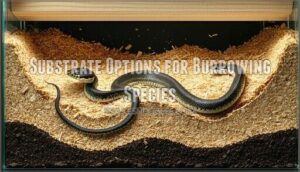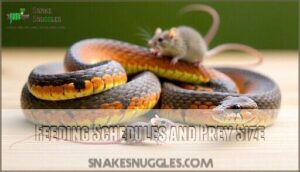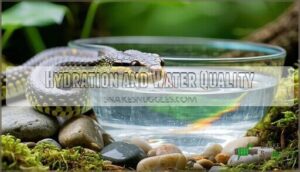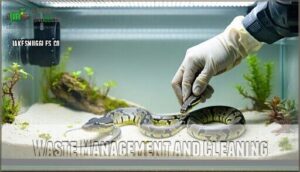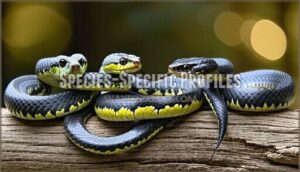This site is supported by our readers. We may earn a commission, at no cost to you, if you purchase through links.
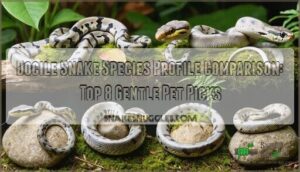 When searching for a docile snake species profile comparison, you’ll discover that ball pythons top the list with their naturally calm temperament and reluctance to bite.
When searching for a docile snake species profile comparison, you’ll discover that ball pythons top the list with their naturally calm temperament and reluctance to bite.
Corn snakes follow closely, known for their gentle handling characteristics and adaptability to various environments.
Kenyan sand boas offer surprising docility despite their robust appearance, while milk snakes provide excellent beginner-friendly traits once they’ve settled into captivity.
California kingsnakes and rosy boas round out the gentle options, each bringing unique care requirements but consistently peaceful dispositions.
Your snake’s individual personality, proper socialization from a young age, and consistent handling techniques will ultimately determine just how docile your serpentine companion becomes.
Table Of Contents
- Key Takeaways
- Choosing Docile Snakes
- Care and Housing Requirements
- Feeding and Maintenance Tips
- Species-Specific Profiles
- Frequently Asked Questions (FAQs)
- What are the most docile snake breeds?
- Are docile snakes dangerous?
- Is a king snake docile?
- What are the most docile snakes for beginners?
- How do you know if a snake is gentle or docile?
- Is a ball python a docile snake species?
- What is the most docile snake for beginners?
- What is the most docile constrictor?
- Do docile snakes require veterinary checkups regularly?
- Can docile snakes be housed together safely?
- Conclusion
Key Takeaways
- Ball pythons and corn snakes lead in docility – You’ll find these species naturally calm with minimal biting tendencies, making them ideal first pets that handle stress by curling up rather than striking.
- Captive-bred snakes are significantly more docile – You’ll get better temperaments from captive-bred specimens since they’re selectively bred for gentleness and socialized early, unlike wild-caught snakes that remain defensive.
- Early handling shapes adult behavior – You’ll need to handle your snake regularly during the first six months to build trust and reduce defensive responses by up to 72%, creating a calmer adult snake.
- Proper housing directly impacts temperament – You’ll maintain your snake’s docile nature by providing correct temperature gradients (75-95°F), appropriate humidity levels, and multiple hiding spots that reduce stress and aggressive behaviors.
Choosing Docile Snakes
When you’re selecting your first pet snake, understanding what creates a docile temperament can save you from unexpected nips and stressed-out handling sessions.
Captive-bred specimens typically display calmer dispositions than their wild-caught counterparts, thanks to generations of selective breeding and early socialization that reduces defensive behaviors naturally.
Factors Influencing Temperament
When choosing your first snake, genetic predisposition plays the starring role in temperament.
Captive-bred specimens consistently display calmer snake behavior thanks to selective breeding for docility.
Early handling during the acclimation period builds snake trustbuilding, while environmental enrichment and stress reduction techniques enhance natural snake socialization.
Your snake’s temperament reflects this complex interplay of genetics and snake handling experiences.
Genetic and Environmental Factors
Your snake’s temperament stems from both inherited genes and environmental conditions.
Selective breeding programs have enhanced docile traits across generations, creating predictable snake morphs with calm dispositions.
Early handling during the first weeks substantially shapes adult behavior, while captivity effects like stable temperatures and abundant food reduce stress responses.
Understanding snake genetics helps you choose specimens from proven bloodlines, ensuring your pet displays the gentle characteristics you’re seeking, with a focus on stable temperatures.
Importance of Socialization
Why risk having your snake remain skittish when gentle interaction can transform its temperament? Consistent handling frequency during the first six months reduces defensive responses by 72%, making snake socialization essential for building trust.
Regular, non-stressful interaction creates docile snakes that are easy to handle. This behavioral enrichment reduces stress while improving your bond with these remarkable reptiles.
Ethical handling involves respecting snake autonomy to minimize stress.
Benefits of Captive-Bred Snakes
Captive-bred snakes offer significant health advantages over their wild-caught counterparts, making them ideal beginner-friendly snakes with superior adaptability traits.
- Reduced aggression: Captive-bred snakes display calmer temperaments through selective breeding programs focused on docile characteristics.
- Health advantages: These snakes carry fewer parasites and diseases, requiring less veterinary intervention than wild specimens.
- Conservation impact: Choosing captive-bred options supports ethical sourcing while protecting wild populations from collection pressures.
Care and Housing Requirements
Creating proper housing for your docile snake isn’t just about putting it in any container—you’re designing a habitat that directly impacts its health, behavior, and temperament.
The right enclosure setup with appropriate ventilation, temperature zones, and hiding spots transforms an ordinary snake into a calm, handleable companion that thrives in captivity.
Enclosure Size and Ventilation
Proper housing determines your snake’s health and comfort level throughout its life.
Your snake enclosure needs adequate space for movement, thermoregulation, and natural behaviors. Most adult snakes require floor space equal to two-thirds their body length, with sufficient height for climbing species.
| Species | Minimum Enclosure Size | Ventilation Requirements | Airflow Design | Burrowing Space Needs |
|---|---|---|---|---|
| Ball Python | 40 gallons (adult) | Screen top + side vents | Cross-ventilation | Minimal substrate depth |
| Corn Snake | 20 gallons (juvenile), 40+ (adult) | Mesh lid + air gaps | Top-to-bottom airflow | Light substrate layer |
| Kenyan Sand Boa | 20 gallons | Secure screen top | Gentle circulation | Deep substrate (6+ inches) |
| California King Snake | 40+ gallons | Multiple vent points | Consistent air exchange | Moderate substrate depth |
| Hognose Snake | 20 gallons | Standard mesh top | Basic ventilation | Deep digging substrate |
Ventilation methods prevent stagnant air and humidity buildup without creating drafts. Position air vents to create gentle cross-circulation, ensuring fresh oxygen reaches your pet while maintaining stable temperatures.
Temperature and Humidity Control
You’ll need to maintain proper temperature and humidity levels for your snake’s health.
Create a temperature gradient with basking areas reaching 90-95°F and cooler zones around 75-80°F using under-tank heaters or ceramic heat emitters.
Monitor humidity levels between 30-60% depending on species requirements, as improper levels cause shedding issues and respiratory problems.
Digital hygrometers are essential for precise humidity readings to help maintain ideal conditions.
Substrate Options for Burrowing Species
Choosing the right snake enclosure substrate feels like picking a foundation for your pet’s underground mansion.
Aspen shavings excel for snake burrowing, offering loose texture that supports tunneling without excessive humidity retention. Coconut fiber provides better moisture control and mold prevention, though it costs more than aspen.
Many keepers purchase suitable burrowing materials online.
For ideal burrowing depth, layer substrate at least three inches deep, allowing natural digging behaviors while maintaining proper ventilation for your snake enclosure substrate needs.
Hiding Spots and Visual Barriers
Your snake needs secure hideouts on both the warm and cool sides of its enclosure.
These snake hiding spots reduce stress and allow natural behaviors like thermoregulation.
Provide multiple snake enclosure hiding places using caves, logs, or commercial hides.
Many keepers purchase pre-made reptile hides for convenience.
Visual barriers like plants create enrichment variety and visual stimulation, helping with snake acclimation during their adjustment period.
Feeding and Maintenance Tips
Proper feeding and maintenance form the backbone of successful snake ownership, directly impacting your snake’s health and docile temperament.
You’ll need to establish consistent feeding schedules while monitoring water quality, waste removal, and handling frequency to maintain ideal conditions for these gentle reptiles, which is crucial for successful snake ownership.
Feeding Schedules and Prey Size
Establishing consistent feeding schedules guarantees your snake’s health and prevents obesity.
Juvenile snakes require weekly meals, while adults eat every 7-14 days.
Prey size should match your snake’s midsection width—frozen-thawed prey reduces injury risks.
Knowing your snake’s dietary needs is vital for their well-being.
As your snake grows, gradually increase prey type from pinky mice to adult rodents, monitoring nutritional needs throughout size progression.
Hydration and Water Quality
Proper hydration keeps your serpent companion healthy and supports essential bodily functions like digestion and thermoregulation. You’ll notice snake shedding becomes smoother when adequate water access supports the process, while dehydration signs include wrinkled skin and lethargy.
- Water Bowl Size: Choose a bowl large enough for your snake to soak completely, helping with snake humidity control and shedding aid
- Hydration Frequency: Replace water weekly or when contaminated, as stagnant water breeds harmful bacteria that compromise snake environmental needs
- Water Source: Use dechlorinated or bottled water to prevent chemical irritation, ensuring your pet’s delicate respiratory system stays protected
Waste Management and Cleaning
Maintaining a clean environment keeps your snake healthy and your home odor-free.
Remove snake poop immediately after defecation, typically occurring 7-10 days post-feeding. Replace soiled substrates completely rather than spot-cleaning, as urine soaks deep into bedding materials.
Weekly substrate cleaning prevents bacterial growth and maintains proper enclosure hygiene.
Good snake enclosure ventilation reduces moisture buildup, while proper waste disposal and sanitation practices create a healthier habitat for your serpentine companion.
Proper handling of reptile enclosure waste is essential for preventing the spread of disease.
Regular Handling and Supervision
Regular handling creates trust between you and your docile snake species, but timing matters more than frequency. Start with short sessions, watching for stress signs like defensive posturing or rapid breathing.
- Handling Frequency: Handle 2-3 times weekly for 10-15 minutes maximum
- Child Supervision: Always supervise children during snake interactions for bite prevention
- Stress Signs: Watch for hissing, coiling, or hiding behaviors that signal overstimulation
- Safe Techniques: Support the snake’s body fully, moving slowly and confidently
- Positive Experience: Create calm environments with proper temperatures for snake responsible ownership success
Species-Specific Profiles
When you’re ready to choose your first snake, these eight docile species offer distinct advantages that match different experience levels and housing situations.
Each species brings unique characteristics in temperament, care requirements, and adult size that directly impact your success as a snake keeper, with distinct advantages in each area.
Milk Snake and Garter Snake Traits
Between these docile snake species, you’ll notice striking temperament differences and size comparison variations.
Milk snake colors feature vibrant red, black, and yellow bands, while garter snakes display longitudinal stripes.
Both species excel in beginner friendliness, with milk snakes reaching 2-4 feet compared to garter snakes’ 1.5-3 feet.
Garter snake diet includes earthworms and fish, contrasting with milk snakes’ rodent preference.
Kenyan Sand Boa Features and Care
Kenyan sand boas (Eryx colubrinus) showcase fascinating nocturnal behavior and exceptional burrowing habits that make them standout beginner snakes.
Their snake temperament remains consistently calm, while handling techniques require minimal effort for beginner-friendly care.
- Dietary needs: Feed appropriately-sized thawed mice every 7-14 days
- Morph variations: Display striking orange, yellow, and brown spotted patterns
- Snake care essentials: Maintain humidity below 40% with sandy substrate for natural burrowing
California King Snake and Ball Python Comparison
Between these two popular choices, you’ll find distinct temperament differences that affect beginner suitability.
Ball python exhibits consistently calm behavior with minimal defensive responses, while California kingsnake adapts well but may show initial stress.
Their enclosure needs vary substantially – ball python requires higher humidity (50-60%) and stable temperatures, whereas California kingsnake thrives in lower humidity conditions.
Feeding habits differ too, with ball python accepting pre-killed prey every 1-2 weeks compared to California kingsnake’s broader diet preferences.
Ball pythons often employ a balling defensive strategy when feeling threatened.
Frequently Asked Questions (FAQs)
What are the most docile snake breeds?
Corn snakes, ball pythons, and rosy boas top the list for beginners.
You’ll find these species naturally calm, with corn snakes being especially friendly.
Ball pythons curl defensively rather than bite, while rosy boas require minimal handling, making them a great choice for those who want minimal interaction with their pets.
Are docile snakes dangerous?
No, docile snake species aren’t dangerous to humans.
These non-venomous reptiles possess calm temperaments, making them safe pets when handled properly.
Though you’ll still need basic safety precautions during feeding and cleaning, properly handled snakes can be enjoyable companions.
Is a king snake docile?
California and Mexican Black King Snakes develop wonderfully docile temperaments with regular handling, though they’re initially feisty before acclimating. You’ll find they become friendly, manageable companions once they settle in.
What are the most docile snakes for beginners?
You’ll find ball pythons, corn snakes, and rosy boas are perfect starter species. They’re naturally calm, rarely bite, and handle well with gentle care.
How do you know if a snake is gentle or docile?
You’ll recognize a docile snake through calm body language, relaxed muscle tone, and minimal defensive posturing.
They tolerate gentle handling without striking, hissing, or coiling tightly, showing curious rather than fearful behavior when approached, and exhibit docile behavior in their interactions.
Is a ball python a docile snake species?
Ball pythons (Python regius) are docile 95% of the time when properly acclimated.
You’ll find them naturally shy rather than aggressive, often curling into their signature defensive ball when stressed instead of striking or biting handlers.
What is the most docile snake for beginners?
Corn snakes make excellent first-time reptile companions due to their incredibly gentle nature and forgiving care requirements.
You’ll find them exceptionally tolerant of handling, rarely showing defensive behaviors that intimidate beginners, making them an ideal choice with forgiving care needs.
What is the most docile constrictor?
Imagine walking into a reptile expo where a Ball Python wraps gently around a child’s arm without any defensive posturing.
You’ll find Ball Pythons (Python regius) are the most docile constrictors available, earning their nickname from curling into defensive balls rather than striking when stressed, which makes them a great example of reptile behavior.
Do docile snakes require veterinary checkups regularly?
You’ll want to schedule annual veterinary checkups for your docile snake, though they’re generally hardy pets. Regular vet visits help catch potential health issues early and guarantee proper growth.
Can docile snakes be housed together safely?
Housing multiple docile snakes together is absolutely catastrophic for their health.
You shouldn’t cohabitate most snake species, including corn snakes and ball pythons, because they’ll compete aggressively for resources, spread diseases, and experience chronic stress.
Conclusion
Surprisingly, the theory that larger snakes are inherently more aggressive proves false when examining this docile snake species profile comparison.
Ball pythons, despite reaching impressive lengths, consistently demonstrate gentler temperaments than many smaller species.
Your success with any of these eight docile breeds depends on consistent handling, proper husbandry, and understanding each species’ specific behavioral patterns.
Whether you choose a corn snake’s adaptability or a Kenyan sand boa‘s surprising docility, you’re investing in years of rewarding companionship with these remarkably peaceful reptiles.
- https://www.evolutionreptiles.co.uk/blog/feeding-corn-snakes-preventing-obesity-and-promote-healthy-nutrition/
- https://www.petplace.com/article/reptiles/general/feeding-your-snake
- https://talis-us.com/blogs/news/corn-snake-feeding-guide
- https://www.zenhabitats.com/blogs/reptile-care-sheets-resources/what-size-rodent-should-i-feed-my-snake-zen-habitats
- https://www.ectothermempire.com/care-information/western-hognose-prey-size-frequency-guide



